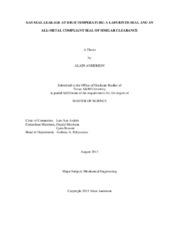| dc.description.abstract | Reducing secondary leakage is a common challenge in numerous machines, particularly in steam and gas turbines. Too large leakage in seals produces a substantial loss in efficiency and power delivery with an increase in specific fuel consumption. Various seal types exist, each with unique advantages and disadvantages as per leakage, power loss, and wear. Labyrinth seals are most common due to their simple design and low cost. Their main drawback is a too high leakage due to enlarged (worn) clearances when a rotor vibrates.
More complicated seal types, such as brush seals can withstand rotor excursions and ensure lower leakage rates than with labyrinth seals. Brush seals utilize a bristle bed which contacts the rotor and wears out thereby reducing leakage performance. The HALOTM seal, an all-metal seal with flexibly supported shoes, is engineered as a clearance control seal to reduce leakage even more, in particular for operation with high pressure differentials and with high surface rotor speeds.
Static leakage tests with hot air at a high temperature (max. 300°C) conducted in a test rig holding a labyrinth seal and a novel all-metal seal (HALOTM seal), both of the same diameter, length and clearance, show the novel seal leaks ~1/5 the flow of a labyrinth seal for pressure ratios (Ps/Pa) > 3.5. The savings in leakage are maximized during operation at high pressure differentials. Leakage measurements with a rotor spinning to a maximum speed of 2,700 rpm (surface speed = 23.6 m/s) produce a slight decrease in leakage with increasing rotor speed.
The research product is a reliable leakage data base enabling the application of a state of the art sealing technology that increases system efficiency by reducing leakage and extends maintenance intervals by eliminating wear of components. | en |


